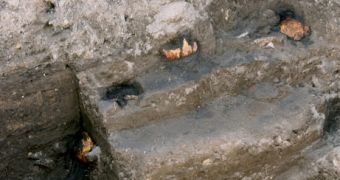The Aztecs founded their bloody empire around A.D. 1200, and their civilization lasted only 300 years, while their empire dominated the area only 100 years before falling under the sword of the conquistadors. Still, at its peak, the empire spread from central Mexico to Guatemala, and it was one of the most advanced civilizations of America, with cities as larger as those of contemporaneous Europe.
An 800-year-old Aztec pyramid has recently been found in the middle of Mexico City, inside the larger Aztec pyramid called the Grand Temple, at the location of the Aztec city of Tlatelolco.
"If the age of the edifice is confirmed, the discovery could push back the age of Tlatelolco - as well as that of its nearby 'twin city' Tenochtitl?n - by a century or more", said lead researcher Salvador Guilliem, of Mexico's National Institute of Anthropology and History.
"The structure's construction suggests it could have been built as early as A.D. 1100 or 1200, at least a century earlier than historical accounts suggest the city was founded", he added.
The work of his team is trying to solve many mysteries of the Grand Temple.
"Until now we thought Tlatelolco's Grand Temple had seven phases of construction. Now we know that there are eight", Guilliem told National Geographic News.
Ground-penetrating radar allowed the discovery of human remains and grave offerings, near the Grand Temple. "We dug 2 meters [6.5 feet] and found an offering of green stones and five skulls. The remains-belonging to four adults and a child-appear to have been positioned with heads turned toward the north and bodies to the south. We think this building corresponds to the military elite", he said.
Aztec legends suggest that Tlatelolco was constructed around A.D. 1358, at the same time with Tenochtitl?n, but recent researches have questioned this.
"If true, the date of this pyramid fits with many other archaeological finds that reveal evidence of Aztec occupation earlier than the traditional dates", said Susan Gillespie, an anthropologist at the University of Florida.
Archaeologists know little about the relationship between Tlatelolco, a large market province, and the Aztec capital, Tenochtitl?n.
"The new discovery could challenge the notion that Tenochtitl?n was the dominant twin during the early, entangled development of the two Aztec provinces. There are vague traces in the historical sources that Tlatelolco may have been more powerful than Tenochtitl?n in its early decades. If there was indeed a large pyramid in Tlatelolco in the Early Aztec period, given that no such find exists in Tenochtitl?n, it may suggest that Tlatelolco was indeed the dominant city in their early years", said Michael Smith, an Aztec expert at Arizona State University.
Guilliem's team is convinced that the newly found pyramid was a temple dedicated to Tezcatlipoca Black, the Aztec god of commerce.
"Workers intentionally broke into the smaller pyramid in 1368 while building a subsequent phase. When they broke it, it is very probable that they deposited a deity that's likely to be Tezcatlipoca. They most likely deposited an offering to the deity [Tezcatlipoca Black], conducted a ceremony, [and] then closed it again", said Guilliem.

 14 DAY TRIAL //
14 DAY TRIAL //